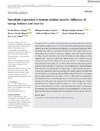Identificador persistente para citar o vincular este elemento:
https://accedacris.ulpgc.es/jspui/handle/10553/58124
| Título: | Sarcolipin expression in human skeletal muscle: influence of energy balance and exercise | Autores/as: | Morales Álamo, David Martinez‐Canton, Miriam Gelabert Rebato, Miriam Martin Rincon, Marcos De Pablos Velasco, Pedro Luis Holmberg, Hans‐Christer López Calbet, José Antonio |
Clasificación UNESCO: | 241106 Fisiología del ejercicio | Palabras clave: | Exercise Obesity Resting energy expenditure Sarcolipin Sprint training |
Fecha de publicación: | 2020 | Proyectos: | Viabilidad y Sostenibilidad Del Adelgazamiento Mediante Tratamiento Intensificado en Pacientes Con Sobrepeso U Obesidad: Mecanismos Neuroendocrinos y Moleculares Estudio Longitudinal de Los Efectos de Una Modificación Intensiva Del Estilo de Vida en la Composición Corporal E Indicadores Bioquímicos y Moleculares de Salud en Pacientes Con Sobrepeso y Obesidad: Aplicación Para la Evaluación Fisiológica de Rutas y Sistemas de Monitorización Del Esfuerzo |
Publicación seriada: | Scandinavian Journal of Medicine and Science in Sports | Resumen: | Sarcolipin (SLN) is a SERCAs uncoupling protein associated with exercise performance and lower adiposity in mice. To determine SLN protein expression in human skeletal muscle and its relationship with adiposity, resting energy expenditure (REE), and performance, SLN was assessed by Western blot in 199 biopsies from two previous studies. In one study, 15 overweight volunteers underwent a pre‐test followed by four days of caloric restriction and exercise (45min one‐arm cranking + 8h walking), and three days on a control diet. Muscle biopsies were obtained from the trained and non‐exercised deltoid, and vastus lateralis (VL). In another study, 16 men performed seven sessions of 4‐6x30‐sec all‐out sprints on the cycle ergometer with both limbs, and their VL and triceps brachii biopsied pre‐ and post‐training. SLN expression was two‐fold and 44% higher in the VL than in the deltoids and triceps brachii, respectively. SLN was associated neither with adiposity nor REE, and was not altered by a severe energy deficit (5,500 kcal/d). SLN and cortisol changes after the energy deficit were correlated (r=0.38, P=0.039). SLN was not altered by low‐intensity exercise in the overweight subjects, whereas it was reduced after sprint training in the other group. The changes in SLN with sprint training were inversely associated with the changes in gross efficiency (r=‐0.59, P=0.016). No association was observed between aerobic or anaerobic performance and SLN expression. In conclusion, sarcolipin appears to play no role in regulating the fat mass of men. Sprint training reduces sarcolipin expression, which may improve muscle efficiency. | URI: | https://accedacris.ulpgc.es/handle/10553/58124 | ISSN: | 0905-7188 | DOI: | 10.1111/sms.13594 | Fuente: | Scandinavian Journal of Medicine and Science in Sports [ISSN 0905-7188], v. 30 (3), p. 408-420 |
| Colección: | Artículos |
Citas SCOPUSTM
11
actualizado el 08-jun-2025
Citas de WEB OF SCIENCETM
Citations
8
actualizado el 08-jun-2025
Visitas
148
actualizado el 27-jul-2024
Descargas
372
actualizado el 27-jul-2024
Google ScholarTM
Verifica
Altmetric
Comparte
Exporta metadatos
Los elementos en ULPGC accedaCRIS están protegidos por derechos de autor con todos los derechos reservados, a menos que se indique lo contrario.
